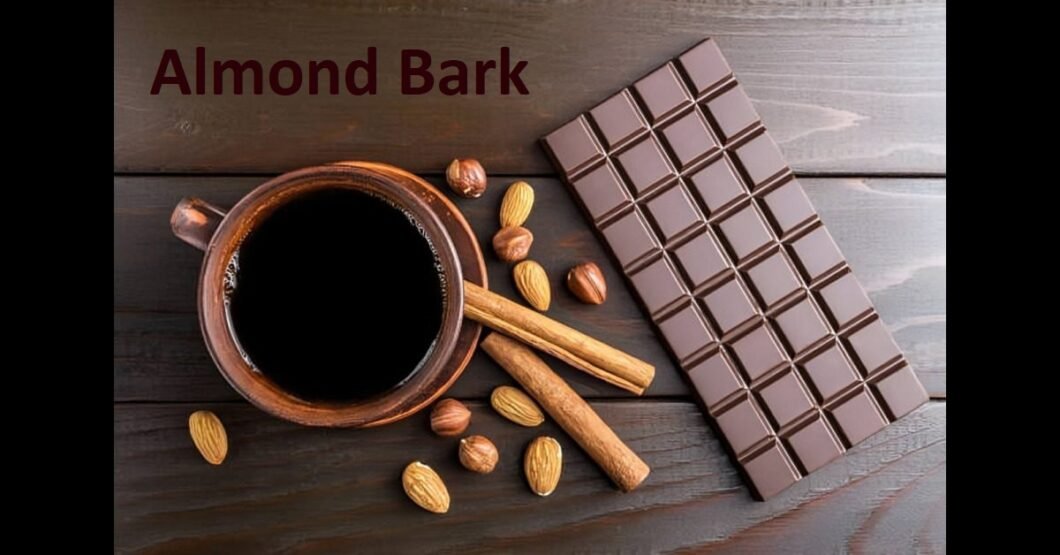Introduction
Almond bark is well known in the world of chocolate confections, is customizable and convenient, and few treats have as much love as this one. Whether you’re snacking on it, dipping your favorite fruits in it, or giving it to someone as a goody bag at Christmas, almond bark has made its mark in the pantry and as a favorite of the dessert industry.
However, there is a twist to this: almond bark is not necessarily what it is all about. Although it can have almonds, it is also a form of chocolate-like coating applied to recipes and food preparation. It is easy to melt and use, hence its popularity with home bakers, chocolatiers, and food entrepreneurs.
Here we are going to pop the hood of everything you need to know about it, its unusual structure, and creative applications, as well as a comparison with the actual chocolate, its healthiness, and homemade recipes. Being a foodie, recipe seeker, or candy-making shortcut searcher, in any case, this guide is your all-inclusive place to become a master of the world of the almond bark.
What Is Almond Bark? Breaking the Chocolate Myth
Almond bark is a name, not necessarily of almonds—or even of real chocolate. It may be misleading, to say the least; however, there is a tasting history and practical explanation as to the name.
What Exactly Is Almond Bark?
It is a confectionary coating that is commonly composed of vegetable fats rather than cocoa butter, as well as flavors such as chocolate or vanilla.
- Stock Colors: They are offered in milk/dark chocolate and white vanilla.
- Forms: Usually in blocks, bars, or melting discs.
- Applications: Melting and coating or as an alternative to chocolate.
Why the Confusion?
- Previously, almond bark meant pieces of chocolate bark that were covered with almonds.
- Marketing has changed the use of almond bark as the coating product in melting and dipping is more commonly called almond bark today.
Knowing the true identity of almond bark makes you apply it in the kitchen in the correct and creative manner.
Almond Bark vs. Chocolate: What’s the Difference?
Almond bark is often thought of as a form of chocolate by amateur bakers and cooks. Let’s address that.
Key Differences Between Almond Bark and Real Chocolate:
| Feature | Almond Bark | Real Chocolate |
| Cocoa Butter Content | ❌ Often absent | ✅ Core ingredient |
| Melting Temperature | Low and quick | Requires tempering |
| Taste | Sweeter, less intense | Rich, deep cocoa flavors |
| Shelf Life | Longer | Shorter (due to dairy/cocoa) |
| Price | Less expensive | More costly per ounce |
When to Use Each:
- Almond bark is used for:
- Dipping pretzels or strawberries
- Easy microwave candy
- Chocolates made from mold
- Use genuine chocolate:
- Make gourmet truffles
- Expensive desserts
- Glossy, tempered coatings
Advice:
It is the better option if convenience is your top concern. But go for real chocolate if flavor is important.
Common Uses of Almond Bark in Everyday Recipes
The ease of melting and the duration of shelf life of it make it very popular to use in daily recipes of desserts.
Top Culinary Uses:
- Dipping:
- Pretzel rods
- Marshmallows
- Vegetables (fruits, bananas, and apples)
- Molding:
- Homemade candy molds
- Chocolate lollipops
- Holiday-themed barks
- Drizzling:
- Over popcorn
- Brownies and cookies
- Binding Ingredient:
- Rice cereal treats
- Nut clusters
- S’mores bars
Bonus Creative Ideas:
- During Christmas use the crushed candy canes to prepare peppermint bark.
- Dress marbled dark and white almond bark.
- Add edible glitter or food coloring in case of themes.
It is indeed a versatile substance that makes it a melt-and-play candy.
Is Almond Bark Healthy? Nutritional Value Explained
It isn’t a particularly healthful snack, let’s face it, but how does it compare nutritionally?
Nutritional Snapshot (Per 28 g/1 oz Serving):
| Nutrient | Amount |
| Calories | ~150 |
| Total Fat | 9–11g |
| Saturated Fat | 6g |
| Sugar | 17g |
| Protein | <1g |
Health Pros:
- Not as fattening as full chocolate
- Most commercial brands contain no trans fat.
- Extended shelf life and little spoiling
Health Cons:
- highly processed and made with vegetable oils rather than cocoa butter
- Frequently contains hydrogenated fats.
- Antioxidants are generally reduced in dark chocolate.
Verdict:
Excellent for decorative purposes and occasional indulgence, but for heart-healthy substitutes, use real dark chocolate.
How to Melt Almond Bark Correctly (Step-by-Step Guide)
The point is to achieve the best texture, which is not difficult as long as it is melted correctly. Here’s how.
Step-by-Step: Microwave Method
- Bark of almond cut in pieces or wafers.
- Put into a microwaveable dish.
- Heat after every half minute, stirring it.
- Stop when the bark becomes smooth and silky.
Stove-Top Double Boiler Method:
- Put chopped almond bark in a heat-resistant bowl.
- Prepare it in a pot with boiling water (do not allow water to touch the bottom of the bowl).
- Continue stirring until melted.
Pro Tips:
- Fill 1 tsp of coconut oil to a more smooth consistency.
- Water in the bark will take away.
You may be dipping or drizzling, but regardless, the technique of perfect melting guarantees gorgeous and shiny outcomes.
Homemade Almond Bark Recipe (Easy & Customizable)
You can have something better than the one you can buy at the store—full of almonds and really good stuff.
Homemade Almond Bark Chocolate Recipe.
Ingredients:
- 2 cups dark chocolate chips
- 1 cup lightly roasted almonds (poorly chopped or whole)
- Sea salt (optional)
Instructions:
- Chocolate may be melted with a microwave or double boiler.
- Stir in almonds.
- Put in a baking sheet lined with parchment paper.
- Add sea salt evenly and sprinkle.
- Allow to come to room temperature or refrigerate for 1 hour.
- Break into pieces and enjoy!
Variations:
- You may use white chocolate, peppermint, or butterscotch.
- Add dry fruits such as cranberries or apricots.
- Layers of peanut butter or caramel.
The DIY almond bark is the most creative, yet simple, and the tastiest one.
Popular Almond Bark Variations Around the World
It is simple to modify it to suit festive occasions and cultural tastes.
Regional Variations:
| Variation | Key Ingredients | Country |
| Peppermint Bark | White chocolate + mints | USA |
| Chikki-Inspired Bark | Jaggery + almonds | India |
| Matcha Almond Bark | White bark + matcha powder | Japan |
| Dark Chocolate Orange | Citrus zest + almonds | UK |
| Coconut Almond Bark | Sweet flakes, toasted nuts | Philippines |
It can be enjoyed in countless ways by experimenting with different flavors and textures.
Almond Bark vs Candy Melts vs Chocolate Chips
Many people are confused by components that appear alike. This is a comparison of it.
| Feature | Almond Bark | Candy Melts | Chocolate Chips |
| Coating Quality | Excellent | Good | Poor |
| Ease of Melting | Very easy | Very easy | Can burn easily |
| Taste | Sweet, mild | Artificial, sweet | Rich, deep cacao |
| Decorative Use | Great | Great | Low |
| Price | Affordable | Affordable | Medium |
Final Thoughts:
- It’s more about appearance than flavor with candy melts.
- It provides a harmonious blend of taste and utility.
- Not for dipping, but for baking, chocolate chips are fantastic.
Storing Almond Bark: Tips for Freshness and Longevity
Almond bark, whether homemade or purchased from a store, maintains its finest appearance and flavor with appropriate storage.
Storage Tips:
- Store in a tightly sealed container.
- Keep between 60°F and 70°F in a cool, dry location.
- Refrigerating is not necessary unless your house is humid.
- Freeze with wax paper in between layers for long-term storage.
Shelf Life:
| Type | Stored Properly | Refrigerated | Frozen |
| Commercial Bark | 6 months | 1 year | 18 months |
| Homemade Bark | 2–3 weeks | 1–2 months | Up to 6 months |
Long-lasting crispness and the absence of bloom (a white, powdery coating) are the results of proper storage.
Almond Bark in the Marketplace: Commercial Brands to Try
Are you trying to find the best brands of it to try?
Top Brands in the Market:
| Brand | Flavor Options | Best For |
| CandiQuik | Chocolate & vanilla | All-purpose, melts smoothly |
| Ghirardelli | Premium chocolate | Gourmet bark, rich taste |
| Great Value | Budget-friendly mix | Dipping, baking, gift baskets |
| Merckens | Colored variations | Holiday/décor chocolate work |
Where to Buy:
- Walmart
- Amazon
- Supplies for baking
- Michaels (for making confectionery)
Select the one that best suits your demands in terms of pricing, melting ease, and flavor quality.
FAQs
Is there almond in almond bark?
Not necessarily. In the vast majority, it is a sort of chocolate-like coating that is melted and also used in candy-making.
Is it possible to substitute chocolate with almond bark?
Yes! It is wonderful to use in dipping and coating. Nevertheless, it does not taste like real chocolate with the rich cocoa taste.
Is it gluten-free/vegan almond bark?
Most of the brands are gluten-free, not necessarily vegan. Never forget to check the label for allergens or dairy.
Why had my almond bark caught or clogged?
That occurs when liquid (such as water or steam) is added to it. It is always advisable to use dry utensils and bowls.
What color shall I add to almond bark?
Apply food coloring, oil-based, as the water-based will destroy the consistency.
Conclusion
Almond bark demonstrates that one does not need a lot to make magic in the sweet realm of chocolate, as with candy barks, fruit dipping, and more. It is convenient, easy to play with, and fast to melt and makes an impression on the plate or in the form of a homemade gift.
Since you have now learned all the ins and outs of it—what it is, how to use it, and how to make it your own—you are now prepared to take your baking to a new level with this all-round confection.
Eat as much as you can—melt some almond bark, and add your fancy to it, and delight in all the limitless flavors.




